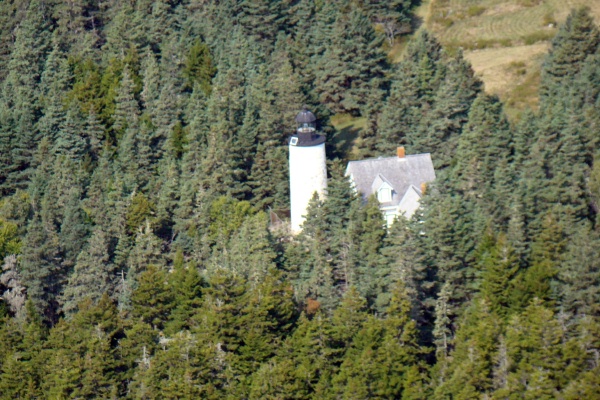LIBBY ISLAND LIGHT, ME. Built in 1822, this active 42' old-style round granite tower with lantern and gallery is attached to a small workroom. Its solar-powered VRB-25 optic has a focal plane 91' above sea level and shows 2 white flashes every 20 seconds. A 4th-Order Fresnel lens thought to have been used in this lighthouse is on display at the Maine Lighthouse Museum in Rockland, ME. The tower is unpainted, the lantern is painted black, the workroom is white with a red roof. Its fog horn sounds a single blast every 15 seconds. The keeper’s house has been demolished; its 1884-built brick fog signal building and 1893-built oil house survive. It is Maine’s third oldest lighthouse–it collapsed due to poor construction and had to be rebuilt in 1824. The Coast Guard removed paint from the tower in 2000 and revealed the original granite. A boat landing and a retaining wall were repaired and the light was converted to solar power. Located on an island in the mouth of Machias Bay, the site and tower are closed. Owned by the US Fish and Wildlife Service, its site manager is the Maine Coastal Island National Wildlife Refuge.
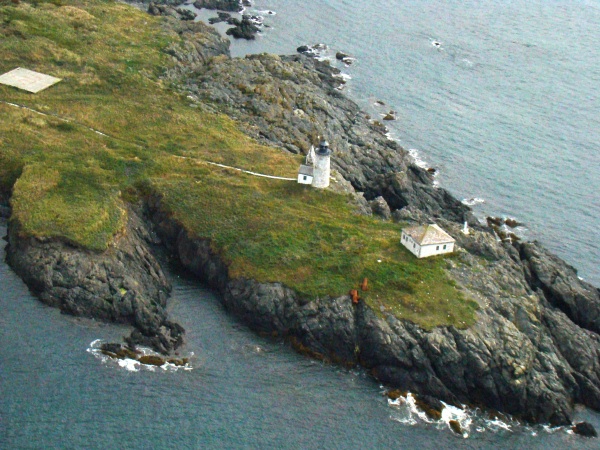
MACHIAS SEAL ISLAND LIGHT, ME. Built by Canada on a U.S.-owned island, the
lighthouse is technically Canadian. Great Britain, and later Canada, have maintained an ongoing interest in the island, largely through continuous occupation of the lighthouse. Until the 1970s–1980s, lighthouse keepers would live on the island with their families, receiving supplies by sea from Grand Manan or Saint John. In recent decades, the island has been protected under its designation as the Machias Seal Island National Wildlife Area (a wildlife and seabird sanctuary), managed by the Canadian Wildlife Service. No private citizen in Canada has made an ownership claim to Machias Seal Island, and Canada considers the property to be wholly owned by the federal government. The island has long been included in federal and provincial electoral districts, and policing has been enforced on the island by Royal Canadian Mounted Police and on waters surrounding the island by the Department of Fisheries and Oceans. In the 20th century, some Canadian residents placed mining claims on the island as an exercise of sovereignty, despite the fact that it is considered a protected area.
The United States has never recognized the construction and continuous occupation of a lighthouse since 1832 by the United Kingdom, and now Canada, to determine the island's ownership, citing several cases worldwide. However, the United States has never maintained an ongoing presence on the island as Canada has and, until recent decades, many branches of the federal and state of Maine governments were inconsistent in their communications: they sometimes have referred to Machias Seal Island as being owned by Canada.
Using the residence on the island, two lightkeepers are flown by helicopter from the coast guard base in Saint John every 30 days to replace the two existing keepers. These coast guard employees also assist the Canadian Wildlife Service in maintaining the National Wildlife Area, as well as helping any wildlife researchers who may stay on the island for a period of time.
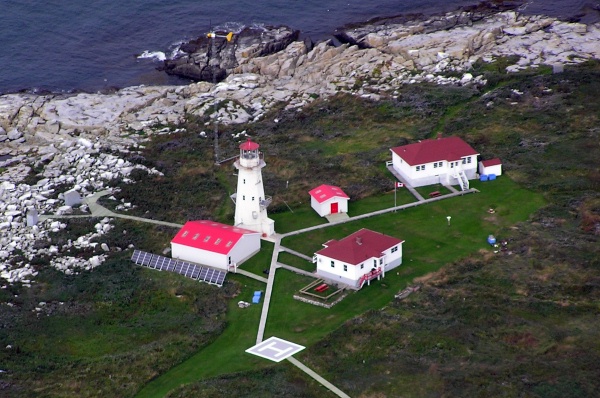
PETIT MANAN LIGHT, ME. This 1855-built active 119' round granite tower with lantern and double gallery has a VRB-25 aerobeacon with a focal plane 123' above sea level that shows a white flash every 10 seconds. Its original 2nd-Order Fresnel lens is on display at the Maine Lighthouse Museum in Rockland, ME. The tower is unpainted, its lantern is painted black. Its fog horn sounds one blast every 30 seconds; its fog bell is on display at the Milbridge Elementary School. An 1875-built 1˝-story Victorian wood keeper’s house provides seasonal housing for Fish and Wildlife service staff and students from the College of the Atlantic. The 1887-built brick fog signal building, an oil house, engine house, and other buildings still exist. The second tallest lighthouse in Maine, Petit Manan is a sibling of Boon Island Light. It was repaired and restored in 1997-‘98. The light was out of service for 2 months in 2001 when a nor’easter
damaged the submarine power cable, resulting in conversion to solar power later in 2001. The light station was listed for transfer under the National Historic Lighthouse Preservation Act in 2004, and in late 2006 ownership was transferred to the Fish and Wildlife Service. Located on a small island off Petit Manan Point, there are hiking trails leading to the Point that provide a view of the lighthouse. The tower is closed. The site is open September through March, and is closed for bird nesting season. The site manager is the Maine Coastal Islands National Wildlife Refuge.
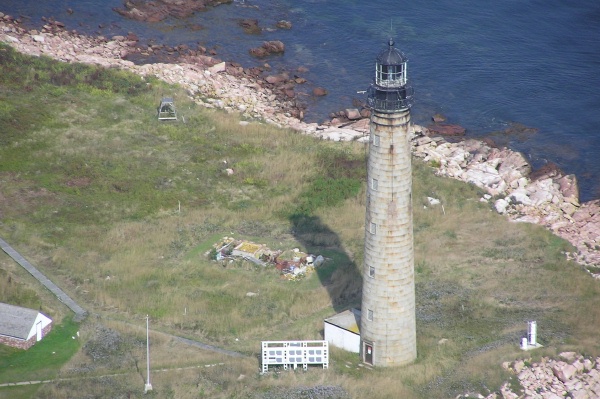
EGG ROCK LIGHTHOUSE, ME. This 1875-built, active 40' square cylindrical brick tower with lantern and gallery rises through the center of the roof of a 1˝-story wood keeper’s house. The original lantern was removed in 1976. The VRB-25 aerobeacon seen today is mounted in a 1986-built replica lantern, has a focal plane of 64' above sea level and flashes red every 5 seconds. The building is painted white, has a red roof, and a black lantern. The 1904-built fog signal building, an oil house, and other buildings are on the site. Its active fog horn sounds 2 blasts every 30 seconds. The design of this integral lighthouse is very unusual for Maine. The lantern was removed in 1976 when a rotating aerobeacon was installed. The Coast Guard installed a new lantern similar to the original in 1986 following public protests.
In the late 1990s the station was transferred to the Fish and Wildlife Service under the Maine Lights program. Located on an island in the mouth of Frenchman Bay about 4 miles southeast of Bar Harbor. The site is open September through March, closed for bird nesting season. The tower is closed. Owned by the U.S. Fish and Wildlife Service, the site manager is the Maine Coastal Islands National Wildlife Refuge.
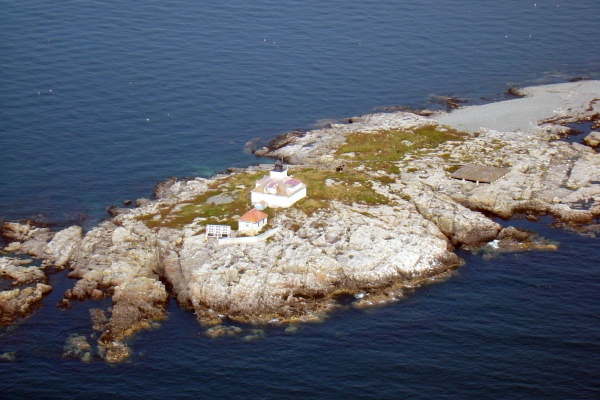
BAKER ISLAND LIGHT, ME. This 1855-built 43' round, cylindrical brick tower with lantern and gallery is adjacent to a 1˝-story wood Cape Cod style keeper’s house to which it was originally attached. Its light was a solar-powered 300 mm lens when it was deactivated in 2002. Its original 4th-Order Fresnel lens is on display in the Fisherman’s Museum at Pemaquid Point Light. The tower is painted white, lantern black. An 1895-built brick oil house and 1905-built shingled fuel house are on the site. Considered a typical Maine lighthouse of its period, the growth of trees made the light difficult to see from the water. The Coast Guard was to discontinue the light in 1991 and again in 1997, the opposition by residents and by succeeded in a reprieve. The Coast Guard and National Park service reached a standoff, unable to agree how trees might be cut to restore visibility of the light without damaging natural values on the island. Replaced by an offshore buoy in 2002, the Park Service replaced the roof of the keeper’s quarters in 2003. The site is open, the tower is closed. Owned by the US Coast Guard, the site manager is the US National Park Service.
